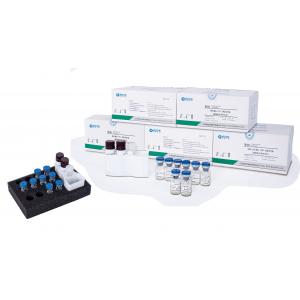
Add to Cart
Glutamic Acid Decarboxylase Antibody In Vitro Diagnostic Reagents (chemiluminescent immunoassay)) in DIABETES
Clinical significance of GAD65 in diabetes
The positive rate of GAD65 in new-onset T1DM patients is about 80%, and the antibody level is relatively stable, with a sustainable high titer for more than 10 years. Adult late-onset autoimmune diabetes mellitus (LADA) with a history of T1DM adult type, treatment independent of insulin, clinical manifestations similar to type 2 diabetes mellitus (T2DM), difficult to differential diagnosis, GAD65 is currently recognized as an immunological indicator for the diagnosis of LADA. Compared with other antibodies, GAD65 has the characteristics of good correlation with the slow injury of B cells, early appearance, long duration, large age span, high positive rate, and easy standardization of detection, which can well predict B cell function.
Clinical significance of GAD65 antibody in other diseases
GAD65 can be detected in the serum of 60%-80% of patients with stiff man syndrome (SMS). The detection of anti-GAD antibodies in the cerebrospinal fluid of SMS patients was more specific. GAD65 can also be detected when T1DM occurs in patients with autoimmune polyglandular syndrome (APS). Many studies have shown that anti-GAD antibodies can damage the structure and function of pancreatic islet B cells, resulting in insulin deficiency and participating in the pathogenesis of T1DM. Regardless of whether it is T1DM or T2DM, GAD65 positive indicates endogenous insulin deficiency and requires insulin therapy in the future.
| Test item | GAD 65 |
| Specification | 100 Test/Box for CIA series |
| 24 Test/Box for POCT | |
| Principle |
|
| Component | Magnetic Beads |
| Calibrator Low | |
| Calibrator High | |
| GAD65 Anti | |
| Control 1 | |
| Control 2 | |
| Accessories Required But Not Provided | Substrate |
| Washing solution | |
| Sample material | serum |
| Sample volume | More than 200μL |
| Storage | 2-8℃ |
| Thyroid | TSH |
| TT3 | |
| TT4 | |
| FT3 | |
| FT4 | |
| TGAb | |
| TPOAb | |
| TRAb | |
| TG | |
| Fertility | FSH |
| PRL | |
| LH | |
| E2 | |
| TESTO | |
| PROG | |
| HCG | |
| P/H-hcg | |
| AMH | |
| Glycometabolism & Hypophyseal Hormone | C-P |
| INS | |
| Hepatic Fibrosis | PIIINP |
| HA | |
| LN | |
| CIV | |
| Tumor Markers | CEA |
| AFP | |
| CA125 | |
| CA19-9 | |
| CA15-3 | |
| CA50 | |
| CA72-4 | |
| CA242 | |
| T-PSA | |
| F-PSA | |
| TK1 | |
| FERRITIN | |
| SCC | |
| NSE | |
| CYFRA21-1 | |
| HE4 | |
| S100 | |
| Hp-Ab | |
| TPS | |
| TNF-α | |
| GP73 | |
| PIVKAⅡ | |
| PACP | |
| Inflammation Monitoring | IL-6 |
| PCT | |
| CRP | |
| CAA | |
| Cardiac | cTn |
| MYO | |
| CK-MB | |
| HFABP | |
| NT-pro-BNP | |
| D-Dimer | |
| HCY | |
| BNP | |
| Lp-pla2 | |
| ST2 | |
| TORCH | |
| Infectious | HBsAg |
| HBsAb | |
| HBeAg | |
| HBeAb | |
| HBcAb | |
| Anti-HCV | |
| Anti-HIV | |
| Anti-TP | |
| NP-IgG | |
| NP-IgM | |
| Kidney Function | NGAL |
| H-ALB | |
| RBP | |
| Cys-C | |
| β2-MG | |
| Gastric Mucosa Function | PGⅠ/Ⅱ |
| PRO-GRP | |
| GRP-17 |

